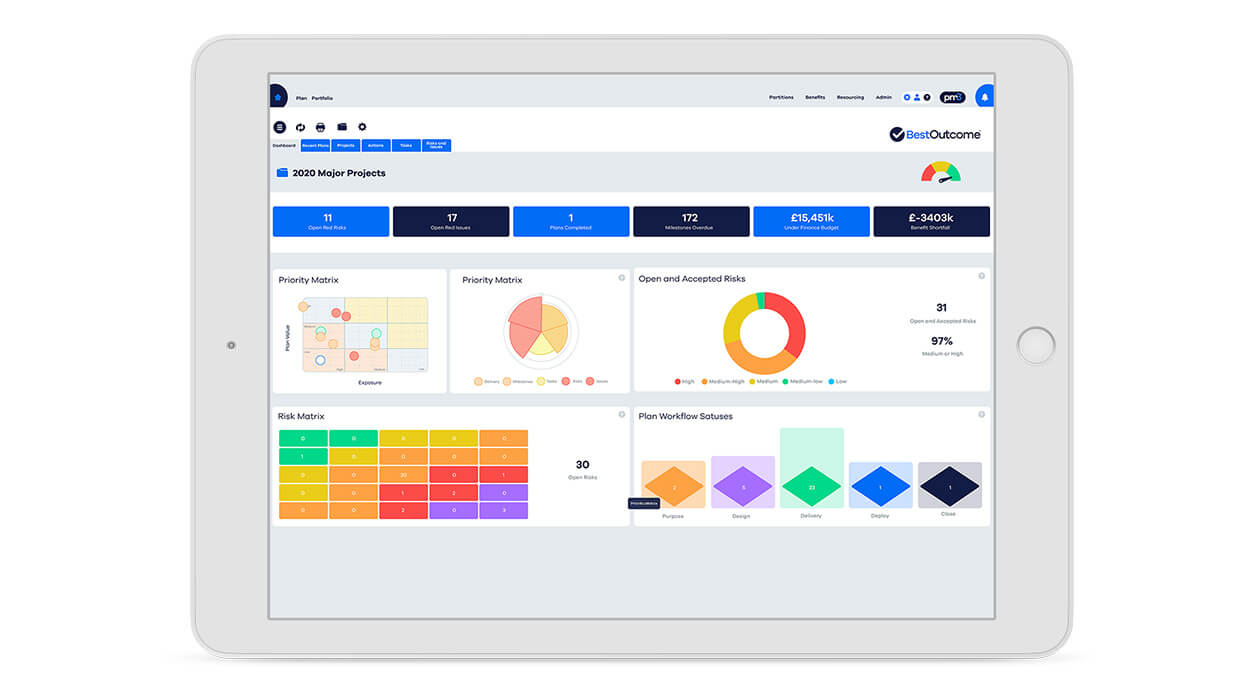Strategic alignment plays a pivotal role in ensuring that each project contributes directly towards the overarching goals of your organization.
This guide is for project managers and professionals involved in business strategy, providing critical insights into aligning project outcomes with business objectives.
We’ll look at the definition and significance of strategic alignment, distinguish between strategic, organizational and tactical alignment, and outlines the benefits and practical steps for implementing it all in your place of work.
Let’s begin!

Strategic alignment is the process of positioning and steering an organization’s projects, initiatives and operations in such a way that they all directly contribute to an overall strategic objective.
In project management, there are three main types of strategic alignment: vertical, horizontal and dynamic.
Vertical alignment aligns project objectives with the core strategic goals defined by senior management.
This ensures that every project undertaken contributes directly to its long-term vision and mission.
For project managers, this means that your projects must always support overarching strategic objectives, which should be clearly evident to all stakeholders.
Horizontal alignment focuses on ensuring consistency and synergy across different departments and teams.
This is about coordinating efforts across various functional areas to ensure that departments are not working in silos but are interconnected and contributing collectively to the strategic goals.
Dynamic strategic alignment refers to an organization’s ability to adapt its strategies and associated projects in response to sudden change.
It ensures that your organization can stay relevant and sustain a competitive advantage over time.
It demands a lot of agility from project managers as you will need to pivot your projects in response to shifting market dynamics, technological advancements, or competitive pressures.
You will need to be adept at managing dependencies, resources and timelines across projects that may involve multiple departments.

Understanding the nuances between strategic, organizational and tactical layers of alignment can empower you to more effectively position your projects within the broader context of the organization.
This type of alignment connects the objectives of each individual project directly to the enterprise’s long-term goals.
Project outcomes should be clearly defined so they can be mapped to Leadership’s strategic objectives.
This will ensure that every project decision and result supports the broader vision, enhancing overall business performance.
Unlike strategic alignment, which focuses on project outcomes, organizational alignment seeks to optimize the structure and capabilities of the organization as a whole.
It moves beyond individual project goals to encompass the enterprise’s entire architecture, ensuring that all components – culture, operational processes and human resources – are optimized to support a strategic vision.
For example, it will look at how departments coordinate their efforts and share resources to achieve larger objectives.
While strategic alignment sets the direction and organizational alignment structures the journey, tactical alignment ensures the steps taken every day are in the right direction.
It involves aligning the daily tasks and immediate actions of project teams with the overarching organizational goals.
It is critical for maintaining consistency in how strategies are implemented on the ground.
For example,, it might include the adoption of appropriate project management methodologies, such as Agile or Waterfall, to meet the unique demands of each project.
The pursuit of strategic alignment delivers a lot of benefits. These extend across the entire organization, enhancing both project success and overall business health.
Let’s look at the top 6.
When strategic alignment is prioritized, decision-making becomes more informed and purposeful.
Teams are much clearer on the organization’s objectives, allowing them to make choices that directly support the goals.
Such clarity reduces uncertainty and enables faster, more confident decision-making at all levels.
It’s a win-win.
Projects aligned with the strategic goals of an organization are far more likely to receive the necessary support in terms of resources, stakeholder buy-in and prioritization within the company’s portfolio.
Such projects are inherently more viable and face fewer obstacles, leading to higher success rates and more effective achievement of desired outcomes.
Strategic alignment helps the effective allocation and use of resources across the organization.
It ensures that resources are not wasted on low-priority or strategically irrelevant initiatives.
Instead, resources are channeled into projects that offer the greatest potential for strategic contribution, thus maximizing return on investment.
An organization in tune with its strategic objectives can adapt more quickly to changes in the external environment.
It fosters an agile mindset that facilitates rapid pivoting and restructuring in response to new challenges and opportunities.
This agility is crucial in maintaining competitiveness and responsiveness in a dynamic market.
Clear alignment between projects and an organization’s strategic goals improves transparency and communication with stakeholders.
When stakeholders understand how specific projects contribute to strategic objectives, their engagement and support increase.
This leads to smoother project execution and enhances the potential for successful outcomes.
Ensuring that all projects and initiatives contribute to the strategic objectives will sustain their growth and relevance over time.
Quite simply, if all efforts are focused on building capabilities and achieving results that support the long-term mission, you help to secure the organization’s future in the process.
Implementing strategic alignment is a structured process requiring planning and execution.
This is a detailed step-by-step guide to help you become a strategic alignment practitioner.
Let’s go!
The primary foundation of strategic alignment is a clear understanding of the organization’s core objectives.
Senior management need to articulate these goals clearly and ensure they are communicated across all levels of the organization.
These must be SMART objectives. I.e.: Specific, Measurable, Achievable, Relevant and Time-bound.
This is your solid basis for alignment.
Before aligning new projects, assess the current project portfolio to determine how well existing projects and operations align with the strategic objectives.
This assessment should identify gaps, redundancies and misalignments through stakeholder interviews, project audits and performance data analysis.
Ensure that new projects are selected based on their potential to drive the strategic objectives forward.
This involves setting up criteria that projects must meet before they are approved.
Prioritization models, like scoring systems or decision matrices, can help in evaluating and selecting projects based on their strategic relevance.
For strategic alignment to be successful, it is crucial to have the buy-in from all key stakeholders, including senior management, project teams and other affected employees.
Communicate the strategic importance of aligned projects and how they contribute to the organization’s goals.
Regular meetings and updates can keep stakeholders engaged and supportive.
Set project goals that are directly linked to strategic objectives and ensure that the project scope, budget and timelines reflect these goals.
Project management methodologies and tools should facilitate this integration, making it clear how project outputs will achieve strategic outcomes.
Set up key performance indicators (KPIs) to measure how well projects are aligned with and contributing to strategic objectives.
Regular monitoring and reporting of these KPIs will help track progress and identify areas where projects may be deviating from the strategic path.
Adjustments should be made as necessary to realign with the goals.
Develop a culture that values and understands the importance of strategic alignment.
Training and development programs can educate employees about how their roles fit into the broader strategic framework.
Incentives and rewards for achieving alignment can motivate teams to continually seek ways to contribute to strategic goals.
Strategic alignment is not a one-time effort but a continuous process.
Regularly review and refine strategies and alignment practices to adapt to new challenges, changes in the environment, or shifts in strategic objectives.
This ongoing refinement helps to maintain alignment over time, ensuring that the organization remains agile and competitive.

Our PPM tool, PM3, is designed to facilitate strategic alignment. So we are using it as an example here.
Here we explore how PM3’s various features can be instrumental in helping you achieve and maintain this crucial alignment.
PM3’s philosophy is rooted in focusing on project and program outcomes, rather than just the outputs.
This approach ensures that every project undertaken is measured against how well it contributes to the strategic goals of the organization.
By focusing on outcomes, PM3 helps project managers ensure that their projects are not only completed efficiently but also contribute meaningfully to the organization’s long-term objectives.
The decluttered interface of PM3 reduces complexity and focuses on presenting the information that is most relevant for each user, depending on their role.
This targeted information delivery minimizes distractions and helps users concentrate on their specific tasks that align with strategic objectives.
The simplicity of the interface enhances user adoption, making it easier for everyone within the organization to participate in strategic alignment efforts.
Effective resource management is crucial for maintaining strategic alignment, as it ensures that all resources are optimally allocated to projects that support the organization’s strategic goals.
PM3 provides tools for understanding resource pinch points and planning resource allocation across the portfolio.
This enables project managers to adjust resource allocation in real-time to meet strategic priorities, ensuring that critical projects have the necessary resources to succeed.
PM3 offers over 100 out-of-the-box reports and dynamic dashboards, which can be customized to track specific strategic metrics.
These reporting tools allow project managers and executives to monitor the progress of projects in terms of their alignment with strategic objectives.
The ability to build custom reports means that organizations can focus on the specific data that matters most to their strategic goals.
PM3 supports both Waterfall and Agile project management methodologies, allowing organizations to manage projects in the way that best suits their strategic needs.
This flexibility is essential for aligning projects with strategic goals, as it allows project managers to choose the methodology that maximizes efficiency and effectiveness based on the specific demands of each project.
The PM3Team app enhances team collaboration by allowing team members to update project status on the go, which ensures that all team members are aligned and informed.
Updates on the app are automatically synchronized with PM3, maintaining consistent and up-to-date project information that is crucial for strategic alignment.
This synchronization helps teams stay on track with strategic objectives and facilitates real-time adjustments as needed.
PM3 is complemented by expert training and mentoring provided by our team of PPM specialists.
This support is crucial for ensuring that all users understand how to use PM3 to its full potential in aligning their projects with strategic goals.
The availability of a learning portal with project management videos, processes and templates further aids organizations in embedding strategic alignment into their daily operations.
—
Main Image: Astrid IQ

Our products help you deliver successful change programs and projects by always focusing on the overall business outcomes. Find out how our products can help you.
Discover PM3